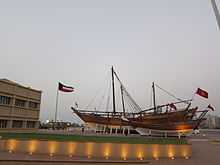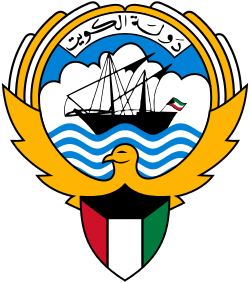Culture of Kuwait
The culture of Kuwait is well known for its cosmopolitanism and seafaring tradition.

Theatre
Kuwait is known for its home-grown tradition of theatre.[1] Kuwait is the only country in the Gulf with a theatrical tradition.[2] The theatrical movement in Kuwait constitutes a major part of the country's cultural life.[3] Theatre activities are still popular today.[3] Theatrical activities in Kuwait began in the 1920s when the first spoken dramas were released.[4]
Arts
Kuwait has the oldest modern arts movement in the Arabian Peninsula.[5] Beginning in 1936, Kuwait was the first Gulf country to grant scholarships in the arts.[5] The Kuwaiti artist Mojeb al-Dousari was the earliest recognized visual artist in the Gulf region.[6] He is regarded as the founder of portrait art in the region.[7] In 1943, al-Dousari launched Kuwait's first art gallery.
Kuwait is home to more than 20 art galleries. Khalifa Al-Qattan was the first Kuwaiti artist to hold a single artist art exhibition in Kuwait. He founded a new art theory in the early 1960s known as "circulism".[8][9] The most prominent female Kuwaiti artists are Thuraya Al-Baqsami and Suzan Bushnaq.
Before the Gulf War, Kuwait was the capital of arts and culture in the Gulf region.[10][11] The arts scene struggled to rebuild after the Gulf War.[10] In recent years, there has been a revival in the arts scene. Kuwait is currently regarded as having the second most lively arts scene in the Gulf, second to Dubai.[12][13]
Museums
Kuwait has approximately 40 museums.
Literature
Kuwait was the pioneer of literary renaissance in the region.[14] In 1958, Al Arabi magazine was first published, the magazine went on to become the most popular magazine in the Arab world.[15] In the 1970s, writers moved to Kuwait where they enjoyed greater freedom of expression than elsewhere in the Arab world.[16]
Music & Dance

The Kuwait pearl diving tradition is known for the songs called Fidjeri. Fidjeri is a musical repertoire performed traditionally by male pearl divers of Kuwait. It involves singing, clapping, drums and dances with earthen water jars. Liwa is a type of music and dance performed mainly in communities which contain descendants of East Africans. Kuwaiti music reflects the diverse influences of many peoples on the culture of Kuwait, including Swahili and Indian music. Khaleeji is a style of folk music from the Persian Gulf area, played in Kuwait with polyrhythms. The style is strongly influenced by the music of Africa and southern Persia.

"Al Arda Al Bahariya" is a well-known Kuwaiti sailor song, as are the al-Nahma, a class of songs that accompanied many sailing activities.
Kuwait is known as the center for sawt, a bluesy style of music made popular in the 1970s. The music of Kuwait follows the traditional mode. It is elaborate and repetitive. It is played on the oud (an ancestor of the lute) and the Rebaba (a one-stringed instrument). Kuwait also has a folk dance tradition.
Kuwait has a reputation for being the central musical influence of the Gulf Cooperation Council countries. Over the last decade of satellite TV stations, there has been a stream of Kuwaiti pop bands that have been successful in reaching other Arab countries with their unique style of pop. Bashar Al Shatty is the most famous young Kuwaiti artist after his appearing in star academy the first season an he gained the second runner.
Gargee'an
Qarqe'an is an annual celebration, observed in Kuwait, that takes place on the 15th night of Sha'ban and on the 15th night of Ramadan. Gerga'oon is marked with children dressing in traditional attire and going door-to-door to receive sweets from neighbours, whilst also singing traditional songs. The tradition has existed for hundreds of years and deeply rooted in Kuwaiti culture.[17]
Although the celebration of Qarqe'an shares superficial similarities with the Halloween custom of trick-or-treating, practiced in some western countries, Qarqe'an has no connection with horror and no associated origin with Halloween.
Cuisine
Seafood has been the mainstay of Kuwaiti cuisine for centuries.
Dewaniya
The Dewaniya has existed in Kuwait since time immemorial. In the old city of Kuwait it was the reception area where a man received his business colleagues and male guests. Today the term refers both to a reception hall and the gathering held in it, and visiting or hosting a dewaniya is an indispensable feature of a Kuwaiti man’s social life. Dewaniya became a fundamental part of Kuwaiti life. Hence, it has become a mark in their traditional daily life.
See also
References
- ↑ "Reviving Kuwait's theatre industry". BBC News.
- ↑ Popular Culture in the Arab World: Arts, Politics, and the Media. p. 277.
- ↑ 3.0 3.1 The World of Theatre: An Account of the Theatre Seasons 1996-97, 1997-98 and 1998-99. p. 147.
- ↑ The World Encyclopedia of Contemporary Theatre: The Arab world.
- ↑ 5.0 5.1 Grove Encyclopedia of Islamic Art & Architecture: Three-Volume Set. p. 405.
- ↑ "Correcting misconceptions of the Gulf’s modern art movement".
- ↑ "Kuwait".
- ↑ "Khalifa Qattan, Founder of Circulism".
- ↑ "Sheik of the Artists: Khalifa Qattan and Circulism (video project)".
- ↑ 10.0 10.1 "Young faces enliven Kuwait's faded art scene".
- ↑ "Cultural developments in Kuwait".
- ↑ "Kuwait".
- ↑ "Collaboration A Must To Revive Arts Scene".
- ↑ "Kuwait Literary Scene A Little Complex".
- ↑ "Kuwait Literary Scene A Little Complex".
A magazine, Al Arabi, was published in 1958 in Kuwait. It was the most popular magazine in the Arab world. It came out it in all the Arabic countries, and about a quarter million copies were published every month.
- ↑ "News Media in the Arab World: A Study of 10 Arab and Muslim Countries". p. 24.
- ↑ "القرقاعون من أهم الاحتفالات الرمضانية الشعبية في مملكة البحرين". Bahrain News Agency. 2 August 2012. Retrieved 3 February 2013.
| |||||||||||||||||||||||||||||||||||||||||
